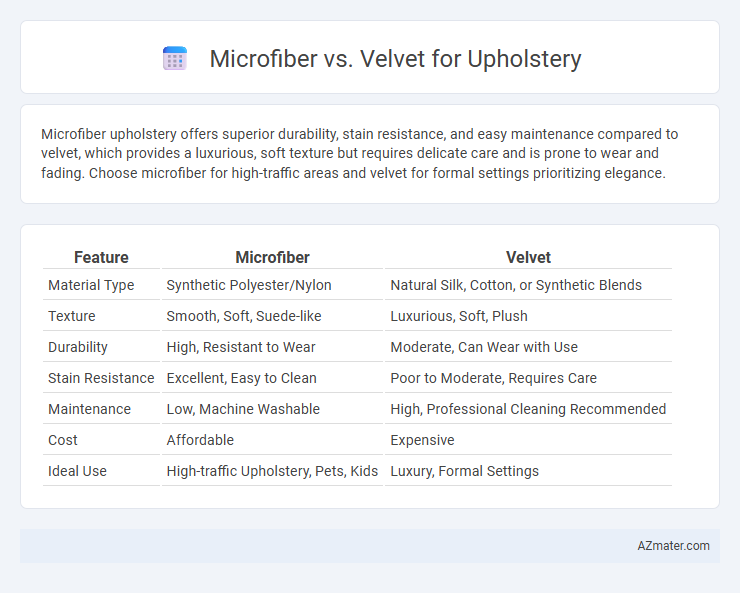Microfiber upholstery offers superior durability, stain resistance, and easy maintenance compared to velvet, which provides a luxurious, soft texture but requires delicate care and is prone to wear and fading. Choose microfiber for high-traffic areas and velvet for formal settings prioritizing elegance.
Table of Comparison
| Feature | Microfiber | Velvet |
|---|---|---|
| Material Type | Synthetic Polyester/Nylon | Natural Silk, Cotton, or Synthetic Blends |
| Texture | Smooth, Soft, Suede-like | Luxurious, Soft, Plush |
| Durability | High, Resistant to Wear | Moderate, Can Wear with Use |
| Stain Resistance | Excellent, Easy to Clean | Poor to Moderate, Requires Care |
| Maintenance | Low, Machine Washable | High, Professional Cleaning Recommended |
| Cost | Affordable | Expensive |
| Ideal Use | High-traffic Upholstery, Pets, Kids | Luxury, Formal Settings |
Introduction to Upholstery Fabrics
Microfiber and velvet stand out as popular upholstery fabrics due to their unique textures and durability. Microfiber, composed of tightly woven synthetic fibers, offers stain resistance and easy maintenance, making it ideal for high-traffic areas. Velvet, known for its soft pile and luxurious appearance, provides an elegant aesthetic while requiring more careful upkeep to preserve its rich texture.
Key Differences Between Microfiber and Velvet
Microfiber upholstery features a synthetic fiber composition that offers high durability, stain resistance, and easy maintenance, making it ideal for high-traffic areas. Velvet, traditionally made from silk, cotton, or synthetic fibers, provides a luxurious texture and rich appearance but requires more delicate care and is prone to crushing and staining. Key differences include microfiber's superior practicality and moisture resistance, contrasted with velvet's superior elegance and plush softness, influencing choice based on lifestyle and aesthetic preferences.
Fabric Composition and Texture
Microfiber upholstery is made from ultra-fine synthetic fibers, usually polyester or nylon, resulting in a tightly woven fabric that is durable, stain-resistant, and easy to clean. Velvet is woven from natural fibers such as cotton or silk, or from synthetic fibers like polyester, featuring a plush pile surface that offers a soft, luxurious texture but requires more delicate care. The distinct fiber composition and surface texture of microfiber provide practical performance benefits, while velvet's rich, tactile feel enhances aesthetic appeal in upholstery applications.
Durability and Longevity
Microfiber upholstery offers superior durability due to its synthetic fibers that resist stains, wear, and fading, making it ideal for high-traffic areas. Velvet, while luxurious and soft, is more susceptible to crushing, matting, and wear over time, requiring delicate maintenance to preserve its appearance. Choosing microfiber over velvet enhances the longevity of furniture, especially in homes with pets, children, or frequent use.
Comfort and Softness Comparison
Microfiber upholstery offers exceptional softness with a smooth, suede-like texture that resists stains and maintains comfort over time, making it ideal for high-traffic areas. Velvet provides a luxurious, plush feel characterized by its dense pile and rich texture, delivering superior softness that enhances the tactile experience and aesthetic appeal. Both materials excel in comfort, but microfiber's durability and easy maintenance contrast with velvet's opulent softness and elegant appearance.
Stain Resistance and Maintenance
Microfiber upholstery offers superior stain resistance due to its tightly woven synthetic fibers that repel liquids and resist dirt, making it easier to clean with simple soap and water. Velvet, especially natural velvet, tends to absorb spills quickly and often requires professional cleaning, although synthetic velvet blends improve durability and stain resistance. Maintenance for microfiber is low, needing regular vacuuming and spot cleaning, while velvet demands gentle care, including specialized vacuum attachments and careful treatment of stains to preserve its texture and appearance.
Color Variety and Aesthetic Appeal
Microfiber upholstery offers a broad color variety, featuring rich, vibrant hues that resist fading and maintain a consistent appearance over time. Velvet's aesthetic appeal lies in its luxurious texture and depth of color, creating a sophisticated, elegant look with subtle light reflection that enhances room ambiance. Choosing between microfiber and velvet depends on the desired balance of durability, color richness, and tactile sophistication for interior design.
Cost and Affordability
Microfiber upholstery offers a cost-effective alternative to velvet, often priced significantly lower due to its synthetic fiber composition and mass production. Velvet, known for its luxurious texture and appearance, commands higher prices because of its natural fibers like silk or cotton and the intricate weaving process. For budget-conscious consumers seeking durability and ease of maintenance, microfiber provides an affordable upholstery solution without sacrificing style.
Best Applications for Microfiber and Velvet
Microfiber excels in high-traffic areas such as family rooms or homes with pets due to its durability, stain resistance, and ease of cleaning. Velvet offers a luxurious, soft texture ideal for formal living rooms, bedrooms, or accent pieces where aesthetic appeal and comfort are prioritized over heavy wear. Choosing microfiber suits practical, everyday use, while velvet enhances elegance and style in low-traffic settings.
Which Upholstery Fabric is Right for You?
Microfiber offers durability and stain resistance, making it ideal for high-traffic areas and homes with pets or children, while velvet provides a luxurious texture and rich appearance suited for formal or low-traffic spaces. Consider microfiber's easy maintenance and ability to repel liquids, contrasting with velvet's need for careful cleaning and its propensity to show wear over time. Evaluate lifestyle factors, room function, and desired aesthetic to determine whether microfiber's practicality or velvet's elegance aligns better with your upholstery needs.

Infographic: Microfiber vs Velvet for Upholstery
 azmater.com
azmater.com